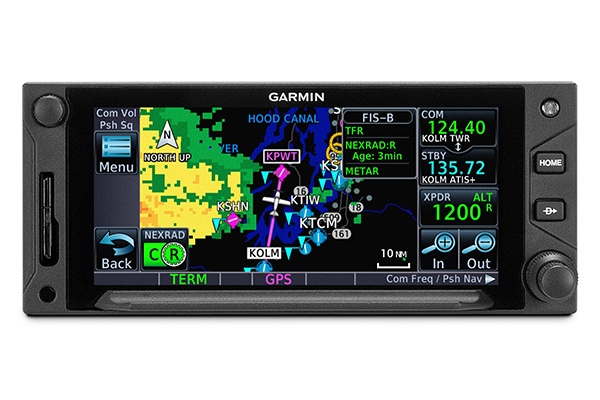Today's flight was another in the progression of stepping further away from home plate and practicing some proper cross country navigation. This allows for putting into practice some of the flight planning, weather briefing, and fuel management skills which don't get much airtime when flying locally.
In this case, the weather briefing and overall real-world weather couldn't have been better (or simpler). A solid high pressure system kept not only the skies clear but the winds light and temperatures mild. So while I went through all the steps, there wasn't much that required any special concern, or even any special fuel planning. With no significant headwinds or tailwinds either direction, it amounted to simply multiplying the fuel burn by the expected time en route. Similarly, there was no significant wind correction to apply, so simply flying the GPS course was sufficient to arrive at Point B.
Before departing the local field, I did a couple of touch and go's just to get into the rhythm and mentally prepare for the longer flight. I think this might be a good practice overall, and will try to do it as much as possible, at least when flying solo. It keeps the skills a bit fresher and adds a bit of a safety factor compared to, say, airline pilots who just hop in and fly multiple hours every day. After not flying for even a few days, it feels a bit wrong to do that when I have no idea what lies at my destination (or even a few miles out). Similar to venturing into shallow ocean waves before diving in, this re-acclimates my flying mind to the environment.
Coincidentally, I decided to just do two landings before departing for the horizon. It turns out this was a fortuitous decision, as a Cirrus in the pattern right behind me decided to blow a tire and close the runway while it was repaired. I heard all the commotion as I was climbing out and was glad I didn't have to get into the middle of that.
One of the key decisions for this flight was choosing a cruise altitude. I wanted to stay relatively low and below the height (3,000 AGL) which would require an FAA-dictated VFR altitude based on my direction of flight. But I also was a bit cautious of rising terrain and the possibility of some turbulence as I crossed over a particular ridgeline midway through the flight. I opted for flying roughly 2,500 ft AGL, which provided a nice, smooth ride. As I approached the ridge (one I have never flown over on my own) I predicted that I would experience some rising and falling air currents. To my surprise I was actually correct and felt the mild ups and downs about where I expected. For the return flight, I flew just a couple of hundred feet higher since it was likely going to be a more turbulent headwind, and while I still felt the bumps, they didn't toss me around too much.
Also on the return flight, I started noticing louder wind noise and a bit of a whistling sound. Indeed, though my altitude hadn't changed, the airspeed had jumped up apparently due to a bit of a windshear or different flow. I powered back and rode through it to keep the speed at about 90 knots. But the strange whistling kept coming and going. Maybe the wind direction was causing a strange pressure zone around the doors or air vents? I never figured out what it was.
Returning to home base, the winds had picked up a bit, and there was what felt like a bit of thermal activity - not unexpected for a late summer afternoon. I also had to blend in with the other traffic again. In this case, I planned on crossing overhead and then entering a 45-degree teardrop to the downwind. As I approached the field, I heard an inbound regional jet setting up for the opposing runway direction on a long straight-in. I asked over the radio how long before they would be at the field and the response was "three to five minutes". That didn't give me much time to come back around and not rush my pattern, so I announced that I would back off, exit the pattern and stay clear until they landed. However, another plane had also entered the area, and was sort of stuck behind me. We both ended up circling for what felt like more than five minutes while the regional jet finally made it in. I was in the process of coming back around into a base-leg turn, but hadn't had a chance to descend from pattern altitude. I ended up too high and too fast as I entered final, and knew I would not be making a stabilized approach - so I did a go-around.
This I think was a good decision as it allowed the other plane to come in a bit quicker (they didn't say anything, but something about the tone of their voice made it seem like they wanted to get down) - not to mention it kept me from doing something drastic just to get the plane on the ground when there was no urgency.
I did a couple more touch and go's, with a right crosswind that gave me a bit of trouble and caused my last landing to be quite a bit long. So, more work needed there.
Since this was still a relatively short cross-country, I didn't need to do much cross checking of fuel burn and progress, but this is a key item for any longer flights in the future.


